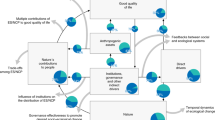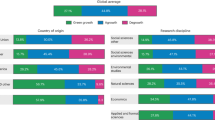Abstract
Despite general agreement that meeting food demand without further loss of natural ecosystems requires sustainable intensification, there is little dialogue about the research agenda needed to achieve it. To that end, we evaluate current trajectories towards sustainable intensification, review published research on the topic, identify missing links, and propose a prioritization framework to fill gaps. Although progress towards sustainable intensification is behind schedule, we are optimistic that current trends can get back on course assuming a well-prioritized and adequately funded research portfolio and appropriate policies and institutions to support it.
This is a preview of subscription content, access via your institution
Access options
Access Nature and 54 other Nature Portfolio journals
Get Nature+, our best-value online-access subscription
$29.99 / 30 days
cancel any time
Subscribe to this journal
Receive 12 digital issues and online access to articles
$119.00 per year
only $9.92 per issue
Buy this article
- Purchase on Springer Link
- Instant access to full article PDF
Prices may be subject to local taxes which are calculated during checkout




Similar content being viewed by others
References
Pretty, J. & Bharucha, Z. P. Sustainable intensification in agricultural systems. Ann. Bot. 114, 1571–1596 (2014).
Cassman, K. G. Ecological intensification of cereal production systems: yield potential, soil quality, and precision agriculture. Proc. Natl Acad. Sci. USA 96, 5952–5959 (1999).
Godfray, H. C. J. & Garnett, T. Food security and sustainable intensification. Phil. Trans. R. Soc. B 369, 20120273 (2014).
Pretty, J. The sustainable intensification of agriculture. Nat. Resour. Forum 21, 247–256 (1997).
Garnett, T. et al. Sustainable intensification in agriculture: premises and policies. Science 341, 33–34 (2013).
Lagi, M., Bertrand, K. Z. & Bar-Yam, Y. The Food Crises and Political Instability in North Africa and the Middle East (SSRN, 2011).
Barrett, C. B. in Food Security and Sociopolitical Stability (ed. Barrett, C. B.) 1–34 (Oxford Univ. Press, 2013).
Grassini, P., Eskridge, K. M. & Cassman, K. G. Distinguishing between yield advances and yield plateaus in historical crop yield trends. Nat. Commun. 4, 2918 (2013).
Bajželj, B. et al. Importance of food-demand management for climate mitigation. Nat. Clim. Change 4, 924–929 (2014).
Stehfest, E. et al. Climate benefits of changing diet. Clim. Change 95, 83–102 (2009).
Tilman, D., Balzer, C., Hill, J. & Befort, B. L. Global food demand and sustainable intensification of agriculture. Proc. Natl Acad. Sci. USA 108, 20260–20264 (2011).
Cassman, K. G., Dobermann, A., Walters, D. T. & Yang, H. Meeting cereal demand while protecting natural resources and improving environmental quality. Annu. Rev. Environ. Resour. 28, 315–358 (2003).
Rockström, J. et al. Sustainable intensification of agriculture for human prosperity and global sustainability. Ambio 46, 4–17 (2017).
Loos, J. et al. Putting meaning back into “sustainable intensification”. Front. Ecol. Environ. 12, 356–361 (2014).
Andrade, J. F. et al. A spatial framework for ex-ante impact assessment of agricultural technologies. Glob. Food Secur. 20, 72–81 (2019).
Tittonell, P. & Giller, K. E. When yield gaps are poverty traps: the paradigm of ecological intensification in African smallholder agriculture. Field Crops Res. 143, 76–90 (2013).
Vanlauwe, B. et al. Sustainable intensification and the African smallholder farmer. Environ. Sustain. 8, 15–22 (2014).
Pretty, J. et al. Global assessment of agricultural system redesign for sustainable intensification. Nat. Sustain. 1, 441–446 (2018).
Mabhaudhi, T. et al. Mainstreaming underutilized indigenous and traditional crops into food systems: a South African perspective. Sustainability 11, 172 (2019).
Barnes, A. P. & Thompson, S. T. Measuring progress towards sustainable intensification: how far can secondary data go? Ecol. Indic. 36, 213–220 (2014).
Gadanakis, Y., Bennett, R., Park, J. & Areal, F. J. Evaluating the sustainable intensification of arable farms. J. Environ. Manag. 150, 288–298 (2015).
Smith, A. et al. Measuring sustainable intensification in smallholder agroecosystems: a review. Glob. Food Secur. 12, 127–138 (2017).
Thomson, A. M. et al. Science in the supply chain: collaboration opportunities for advancing sustainable agriculture. Agric. Environ. Lett. 2, 170015 (2017).
Snapp, S. S. et al. Maize yield and profitability tradeoffs with social, human and environmental performance: is sustainable intensification feasible? Agric. Syst. 162, 77–88 (2018).
Andrade, J. F., Poggio, S. L., Ermacora, M. & Satorre, E. H. Land use intensification in the Rolling Pampa, Argentina: diversifying crop sequences to increase grain yields and resource use. Eur. J. Agron. 82, 1–10 (2017).
Guilpart, N., Grassini, P., Sadras, V. O., Timsina, J. & Cassman, K. G. Estimating yield gaps at the cropping system level. Field Crops Res. 206, 21–32 (2017).
Hall, A. J. & Richards, R. Prognosis for genetic improvement of yield potential and water-limited yield of major grain crops. Field Crops Res. 143, 18–33 (2013).
Cassman, K. G. Long-Term Trajectories: Crop Yields, Farmland, and Irrigated Agriculture 21–46 (Federal Reserve Bank of Kansas City Economic Review, Special Issue, 2016).
Cooper, M., Gho, C., Leafgren, R., Tang, T. & Messina, C. Breeding drought-tolerant maize hybrids for the US corn-belt: discovery to product. J. Exp. Bot. 65, 6191–204 (2014).
Kucharik, C. J. Contribution of planting date trends to increased maize yields in the central United States. Agron. J. 100, 328–336 (2008).
Sacks, W. J. & Kucharik, C. J. Crop management and phenology trends in the U.S. Corn Belt: impacts on yields, evapotranspiration and energy balance. Agric. For. Meteorol. 151, 882–894 (2011).
McLellan, E. et al. Reducing nitrogen export from the Corn Belt to the Gulf of Mexico: agricultural strategies for remediating hypoxia. J. Am. Water Resour. Assoc. 51, 263–289 (2015).
Keating, B. A., Herrero, M., Carberry, P. S., Gardner, J. & Cole, M. B. Food wedges: framing the global food demand and supply challenge towards 2050. Glob. Food Secur. 3, 125–132 (2014).
van Ittersum, M. K. et al. Yield gap analysis with local to global relevance – a review. Field Crops Res. 143, 4–17 (2013).
Grassini, P. et al. How good is good enough? Data requirements for reliable crop yield simulations and yield-gap analysis. Field Crops Res. 177, 49–63 (2015).
van Bussel, L. G. J. et al. From field to atlas: upscaling of location-specific yield gap estimates. Field Crops Res. 177, 98–108 (2015).
van Ittersum, M. K. et al. Can Sub-Saharan Africa feed itself? Proc. Natl. Acad. Sci. USA 113, 14964–14969 (2016).
Deng, N. et al. Closing yield gaps for rice self-sufficiency in China. Nat. Commun. 10, 1725 (2019).
World Population Prospects (United Nations Division of Economics and Social Affairs, 2019).
The 2018 Revision of the World Urbanization Prospects (United Nations Division of Economics and Social Affairs, 2018).
Guilpart, N. et al. Rooting for food security in Sub-Saharan Africa. Environ. Res. Lett. 12, 114036 (2017).
MacDonald, A. M., Bonsor, H. C., Dochartaigh, B. É. Ó. & Taylor, R. G. Quantitative maps of groundwater resources in Africa. Environ. Res. Lett. 7, 021003 (2012).
Cassman, K. G. & Grassini, P. Can there be a green revolution in Sub-Saharan Africa without large expansion of irrigated crop production? Glob. Food Secur. 2, 203–209 (2013).
McLellan, E. L. et al. The nitrogen balancing act: tracking the environmental performance of food production. BioScience 68, 194–203 (2018).
Passioura, J. Increasing crop productivity when water is scarce—from breeding to field management. Agric. Water Manage. 80, 176–196 (2006).
Grassini, P. et al. High-yield irrigated maize in the Western U.S. Corn Belt: II. Irrigation management and crop water productivity. Field Crops Res. 120, 133–144 (2011).
Rattalino Edreira, J. I. et al. Beyond the plot: technology extrapolation domains for scaling out agronomic science. Environ. Res. Lett. 13, 054027 (2018).
Rattalino Edreira, J. I. et al. Assessing causes of yield gaps in agricultural areas with diversity in climate and soils. Agric. For. Meteorol. 247, 170–180 (2018).
Mourtzinis, S. et al. Sifting and winnowing: analysis of farmer field data for soybean in the US North-Central region. Field Crops Res. 221, 130–141 (2018).
Byerlee, D., Stevenson, J. & Villoria, N. Does intensification slow crop land expansion or encourage deforestation? Glob. Food Secur. 3, 92–98 (2014).
Phalan, B. How can higher-yield farming help to spare nature? Science 351, 450–451 (2016).
Commodity Markets (World Bank); https://go.nature.com/39QAzJQ
FAOSTAT: Crops (FAO); http://www.fao.org/faostat/en/#data/QC
Author information
Authors and Affiliations
Contributions
The subject-matter outline of the Perspective was developed by K.G.C. and figures were prepared by P.G. Writing and editing were performed by K.G.C. and P.G.
Corresponding author
Ethics declarations
Competing interests
The authors declare no competing interests.
Additional information
Publisher’s note Springer Nature remains neutral with regard to jurisdictional claims in published maps and institutional affiliations.
Rights and permissions
About this article
Cite this article
Cassman, K.G., Grassini, P. A global perspective on sustainable intensification research. Nat Sustain 3, 262–268 (2020). https://doi.org/10.1038/s41893-020-0507-8
Received:
Accepted:
Published:
Issue Date:
DOI: https://doi.org/10.1038/s41893-020-0507-8
This article is cited by
-
Intensifying rice production to reduce imports and land conversion in Africa
Nature Communications (2024)
-
Harnessing plant–microbe interactions to promote nitrogen use efficiency in cereal crops
Plant and Soil (2024)
-
Research on intercropping from 1995 to 2021: a worldwide bibliographic review
Plant and Soil (2024)
-
Pest management science often disregards farming system complexities
Communications Earth & Environment (2023)
-
Integrated biochar solutions can achieve carbon-neutral staple crop production
Nature Food (2023)



